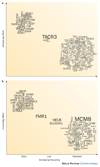Molecular insights into the aetiology of female reproductive ageing
- PMID: 26460341
- PMCID: PMC6309261
- DOI: 10.1038/nrendo.2015.167
Molecular insights into the aetiology of female reproductive ageing
Abstract
As age at pubertal onset declines and age at first pregnancy increases, the mechanisms that regulate female reproductive lifespan become increasingly relevant to population health. The timing of menarche and menopause can have profound effects not only on fertility but also on the risk of diseases such as type 2 diabetes mellitus, cardiovascular disease and breast cancer. Genetic studies have identified dozens of highly penetrant rare mutations associated with reproductive disorders, and also ∼175 common genetic variants associated with the timing of puberty or menopause. These findings, alongside other functional studies, have highlighted a diverse range of mechanisms involved in reproductive ageing, implicating core biological processes such as cell cycle regulation and energy homeostasis. The aim of this article is to review the contribution of such genetic findings to our understanding of the molecular regulation of reproductive timing, as well as the biological basis of the epidemiological links between reproductive ageing and disease risk.
Conflict of interest statement
The authors declare no conflicts of interest.
Figures




References
-
- Chumlea WC, et al. Age at menarche and racial comparisons in US girls. Pediatrics. 2003;111:110–3. - PubMed
-
- Parent A-S, et al. The timing of normal puberty and the age limits of sexual precocity: variations around the world, secular trends, and changes after migration. Endocr Rev. 2003;24:668–93. - PubMed
-
- Remsberg KE, et al. Early menarche and the development of cardiovascular disease risk factors in adolescent girls: the Fels Longitudinal Study. J Clin Endocrinol Metab. 2005;90:2718–24. - PubMed
-
- Hartge P. Genetics of reproductive lifespan. Nat Genet. 2009;41:637–638. - PubMed
-
- Palmert MR, Boepple PA. Variation in the timing of puberty: clinical spectrum and genetic investigation. J Clin Endocrinol Metab. 2001;86:2364–8. - PubMed
Publication types
MeSH terms
Grants and funding
LinkOut - more resources
Full Text Sources
Other Literature Sources
Medical
Research Materials

